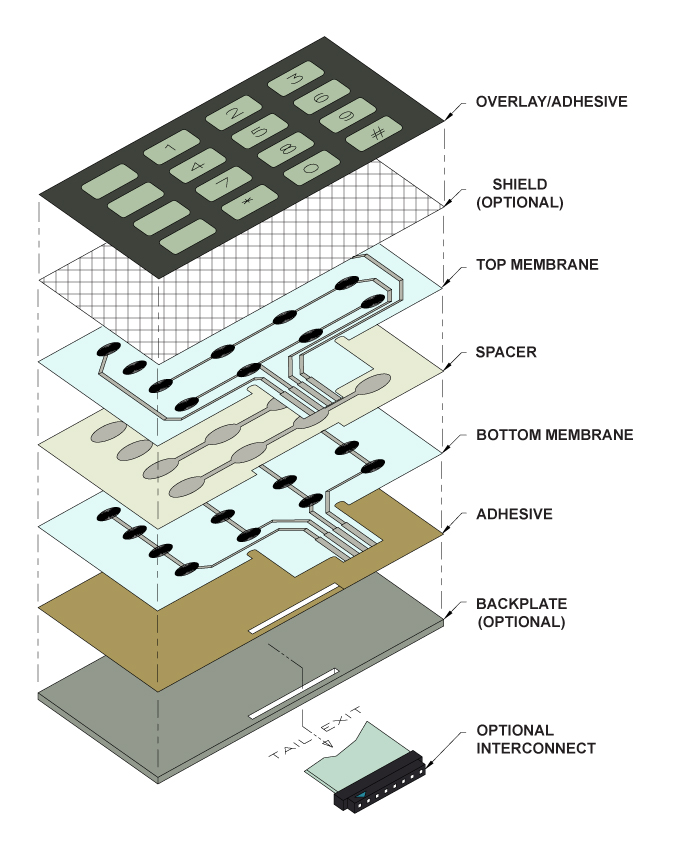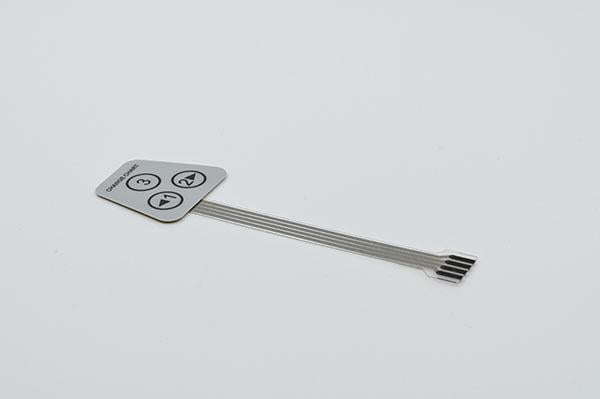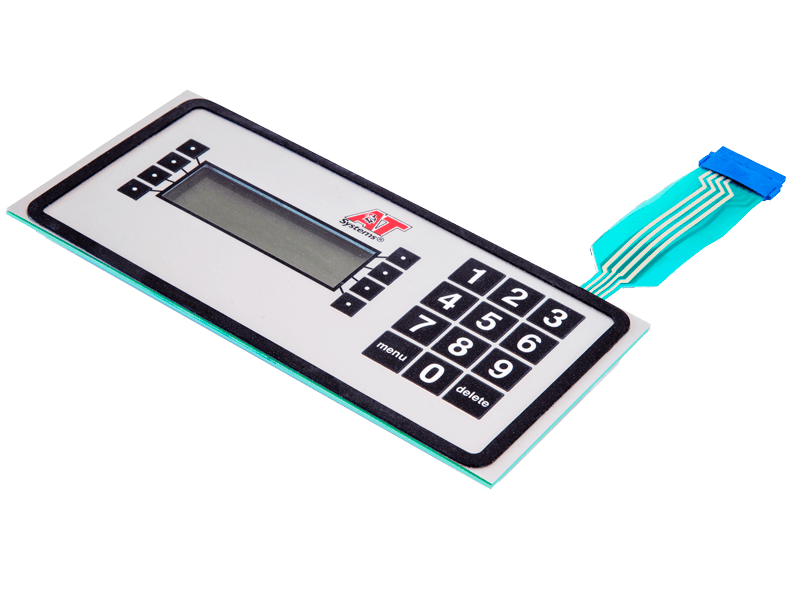All Concerning Membrane Switch Over: Comprehending Its Layout and Capability
When you assume concerning the control interfaces in modern-day devices, membrane switches often come to mind. Allow's discover what collections membrane switches over apart from various other control systems.
What Are Membrane Switches?

Their seamless nature makes them simple to tidy and immune to dirt and wetness, an important function in many settings. Membrane buttons can also be personalized concerning shape, size, and graphics, allowing manufacturers to develop distinct user interfaces tailored to details items. Plus, they're lightweight and thin, which aids in reducing the total bulk of gadgets. On the whole, membrane buttons play a considerable function in boosting customer experience throughout a broad range of applications.
Just How Membrane Changes Job
When you press a trick on a membrane button, it triggers an uncomplicated yet reliable mechanism. The top layer, frequently made of adaptable product, lowers onto a conductive layer under it. This action bridges the space in between conductive traces, finishing an electric circuit. As quickly as the circuit closes, it sends a signal to the tool's controller, which analyzes your input.
You'll see that the responsive feedback differs based on the button design, using either a soft click or a much more noticable response. As soon as you launch the secret, the membrane go back to its initial position, reopening the circuit and stopping the signal. This process takes place virtually instantaneously, ensuring a responsive individual experience.
Membrane buttons are prominent as a result of their sturdiness and resistance to dirt and moisture, making them ideal for different applications, from home devices to medical devices. Recognizing this operation assists you appreciate their widespread use.
Key Parts of Membrane Switches
Recognizing the essential elements of membrane buttons is fundamental for understanding their capability and layout. The safety layer guards against environmental variables and wear, prolonging the button's life-span. By understanding these elements, you'll acquire insight into how membrane layer switches operate and their value in various applications.
Materials Used in Membrane Switch Design
The performance and toughness of membrane switches over greatly depend upon the materials utilized in their layout. You typically encounter polyester and polycarbonate as main substratums as a result of their outstanding toughness and flexibility. These products resist scrapes and chemicals, making them ideal for requiring atmospheres.
The conductive layers commonly make use of silver or carbon, selected for their reliability and conductivity. membrane switch manufacturer. Silver offers exceptional performance, while carbon is a cost-efficient alternative. For the overlay, you may think about a matte or glossy coating, relying on your aesthetic needs and individual experience
Make particular to choose adhesives that stand up to environmental aspects like temperature and moisture. Choosing the best products will certainly guarantee your membrane layer switch stands the examination of time.
Design Factors To Consider for Membrane Switches
While creating membrane layer switches, it's essential to think about different variables that influence their performance and customer experience. Begin by concentrating on the design and button size; make specific they're instinctive and easy to navigate. Think about the responsive responses you intend to offer-- will individuals need an obvious click or a softer touch? Furthermore, consider the products you'll use, as they'll impact longevity and aesthetics.
Don't forget the visuals style; clear labeling and shade contrast are substantial for why not check here exposure. Validate your style fits environmental variables, like dampness or temperature variants, which can influence performance. Finally, why not check here keep in mind the value of screening models with actual users to gather responses and make required adjustments. This iterative procedure aids you fine-tune the style, validating it fulfills both practical and visual demands successfully. By carefully thinking about these elements, you'll develop a membrane button that improves functionality and satisfaction.
Applications of Membrane Layer Buttons
Membrane layer switches are versatile elements located in various applications, from commercial devices to consumer electronic devices. You'll see their effect in devices that call for long lasting user interfaces and in tools that take advantage of streamlined styles. Comprehending these applications helps you value the functionality and practicality of membrane buttons in everyday modern technology.
Industrial Equipment Usage
When you're aiming to enhance the capability of commercial devices, membrane buttons use a reputable service that combines longevity with user-friendly style. These switches are best for rough environments, providing resistance to dust, wetness, and chemicals. You'll find them in control panels for producing devices, a/c systems, and clinical tools, where accuracy and responsiveness are important. Their low profile means they fit effortlessly right into numerous equipment, saving beneficial area while maintaining simplicity of use. With adjustable graphics and backlighting alternatives, you can develop an intuitive user interface for operators, enhancing efficiency and security. And also, their lengthy lifespan minimizes maintenance costs, making them a clever financial investment for your industrial applications. Welcome membrane switches to streamline your operations and enhance total efficiency.
Consumer Electronics Integration
In the domain of customer electronics, membrane layer switches play a vital duty in boosting user communication and tool capability. Membrane switches likewise guarantee resilience and resistance to dust and moisture, extending the lifespan of your electronics. By choosing membrane layer buttons, you enhance not just the performance but additionally the style of your tools, making everyday communications smooth and enjoyable.
Benefits and Downsides of Membrane Layer Switches
While membrane layer switches provide an array of benefits, they also include some drawbacks that you ought to consider. One considerable benefit is their small style, making them suitable for space-constrained applications. They're also cost-effective, supplying a durable remedy with a reduced production price. browse around here In enhancement, their smooth surface is very easy to clean, enhancing health in settings like health centers.

Nonetheless, there are downsides. Membrane buttons can have a much shorter life-span compared to mechanical switches, particularly under hefty usage. They can additionally be much less tactile, which could impact customer feedback during procedure. Furthermore, if damaged, fixing them can be difficult and usually requires full replacement. Ultimately, their level of sensitivity to extreme temperature levels and environmental problems may restrict their efficiency in particular setups. Balancing these pros and cons will certainly aid you establish if membrane layer switches are the right suitable for your task.
Frequently Asked Questions
How Long Do Membrane Layer Switches Typically Last?
Membrane changes typically last in between 5 to 10 years, depending upon usage and environmental problems. You'll intend to evaluate elements like wear, direct exposure to moisture, and temperature level changes to assess their long life properly.
Can Membrane Layer Switches Be Custom-made for Particular Designs?
Yes, you can tailor membrane buttons to fit details layouts (membrane switch manufacturer). You'll have the liberty to pick colors, forms, and formats that match your project's demands, guaranteeing they blend perfectly with your total visual
What Is the Price Range for Membrane Change Production?
The price array for membrane switch production commonly falls in between $1 and $10 each, depending upon elements like style intricacy, amount, and materials. You can get quotes from makers to find the most effective option.

Are Membrane Switches Water Resistant or Immune?
Membrane buttons can be designed to be water resistant or immune, depending on products used and building and construction methods. If you need them for wet settings, guarantee you specify those demands throughout the layout process.
How Do Membrane Changes Compare to Traditional Switches?
Membrane layer buttons are typically thinner and a lot more versatile than conventional buttons, offering a smooth style. They're often much easier to clean and integrate, but might not offer the responsive comments you're made use of to with mechanical options.
Conclusion
